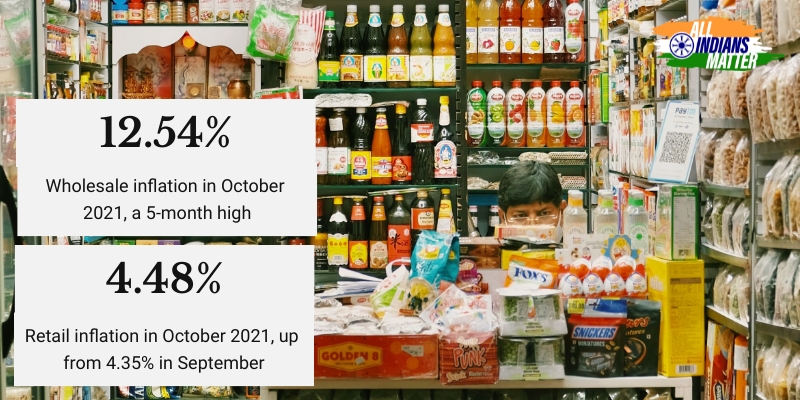Ashraf Engineer
November 20, 2021
EPISODE TRANSCRIPT
Hello and welcome to All Indians Matter. I am Ashraf Engineer.
There’s no respite from rising prices. India’s wholesale inflation rate soared to a five-month high of 12.54% in October compared to a year ago, on the back of high fuel and power costs. These costs drove up prices across the board, from non-food basics to cars. Now this relates to wholesale prices, and is called the wholesale price index – an indicator of what manufacturers charge retailers. Naturally, retail prices have risen too. Retail prices are expressed in the form of the consumer price index, which came in at 4.48% for October compared to a 4.35% rise in September. Let’s now come to core wholesale inflation, which excludes volatile categories such as food and energy. It touched an all-time high of 11.9%. These numbers show how entrenched high prices are and the hole they’re burning into your pocket.
SIGNATURE TUNE
There are several reasons for rising prices. Globally, the disruptions in supply chains caused by the COVID-19 pandemic haven’t eased yet. Supply and logistical constraints have combined with rising demand for goods and services to spark price rises. India, which imports many key raw materials and components, has suffered too.
These shortages include semiconductors, which are used in a variety of appliances – from cars to washing machines and from mobile phones to televisions. Chipmakers are scrambling to increase supply but it’ll take a while. This is why appliance prices were very high during Diwali, when demand is at the highest.
Prices were also driven by higher energy costs – fuel and power inflation surged 37.2% in October following a 24.8% rise in September. These are massive increases in a very short period and they hurt household budgets and the poor the most.
Prices of key inputs such as glass, cotton, steel, copper and chemicals have risen sharply, impacting manufacturers’ margins. Cotton yarn prices, for instance, have surged more than 60% year on year to a decade’s high, hurting India’s garments sector.
Food inflation, meanwhile, rose 3.1% in October from 1.1% in September based on the high prices of edible oils and fruit.
Retailers selling discretionary products such as clothes, electronics and liquor are raising prices by 8% to 10% to make up for raw material and supply chain costs. So, refrigerators, washing machines and microwave ovens are set to get costlier by 5%-6% and will rise again if component and freight costs don’t ease.
The prices of groceries, personal care products, packaged food and dining had risen already and they will rise again.
Recently, the Central Government cut levies of fuel after allowing prices to soar unchecked for ages. Despite that, fuel remains costly.
Many companies have been vocal about inflation concerns, giving the Reserve Bank of India a lot to think about as it sets borrowing costs. They’re low at the moment to shore up an economy devastated by the pandemic.
Hindustan Unilever and Nestle India are suffering from a profit squeeze due to higher input costs and supply chain issues. Companies like and Dabur and Britannia have already passed on increases to customers.
As far as the Reserve Bank is concerned, it has kept borrowing costs low to spur industry and employment. However, industry has warned that inflation would slow demand and thus negate the benefits of low interest rates. This is the dilemma that the Reserve Bank is grappling with.
If there is a demand slowdown, it would have an adverse impact on growth – not something India can afford. Given the serious loss of employment and earnings over the past 18 months, neither can you.
Thank you all for listening. Please visit allindiansmatter.in for more columns and audio podcasts. You can follow me on Twitter at @AshrafEngineer and @AllIndiansCount. Search for the All Indians Matter page on Facebook. On Instagram, the handle is @AllIndiansMatter. Email me at editor@www.allindiansmatter.in. Catch you again soon.






